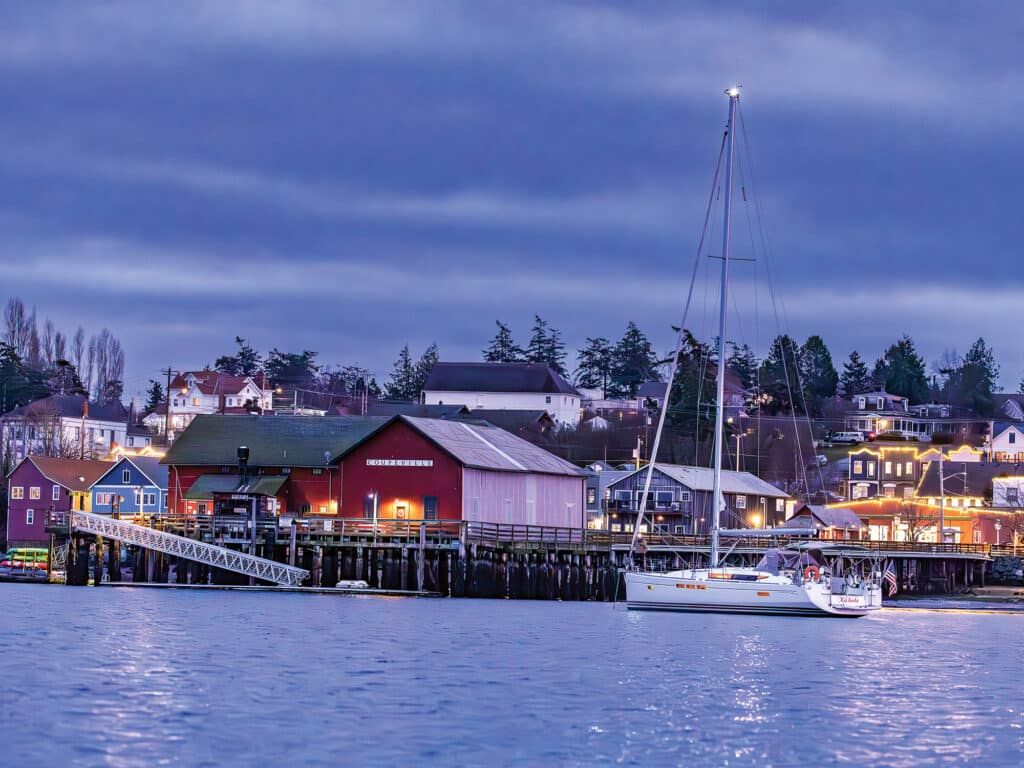
I’m no Ernest Shackleton. I live in Hawaii, and I love the warm weather and clear blue waters of the tropics. Having done a little high-latitude sailing, I have to admit that freezing weather is not my favorite. My boat doesn’t even have a heater.
Yet here I was with Tracy, a surfing friend from Hawaii, ripping down Puget Sound at 12 knots under spinnaker, in the dead of winter. I had on about 10 layers, two puffy jackets, gloves, boots and a hat. I also had a huge smile on my face.
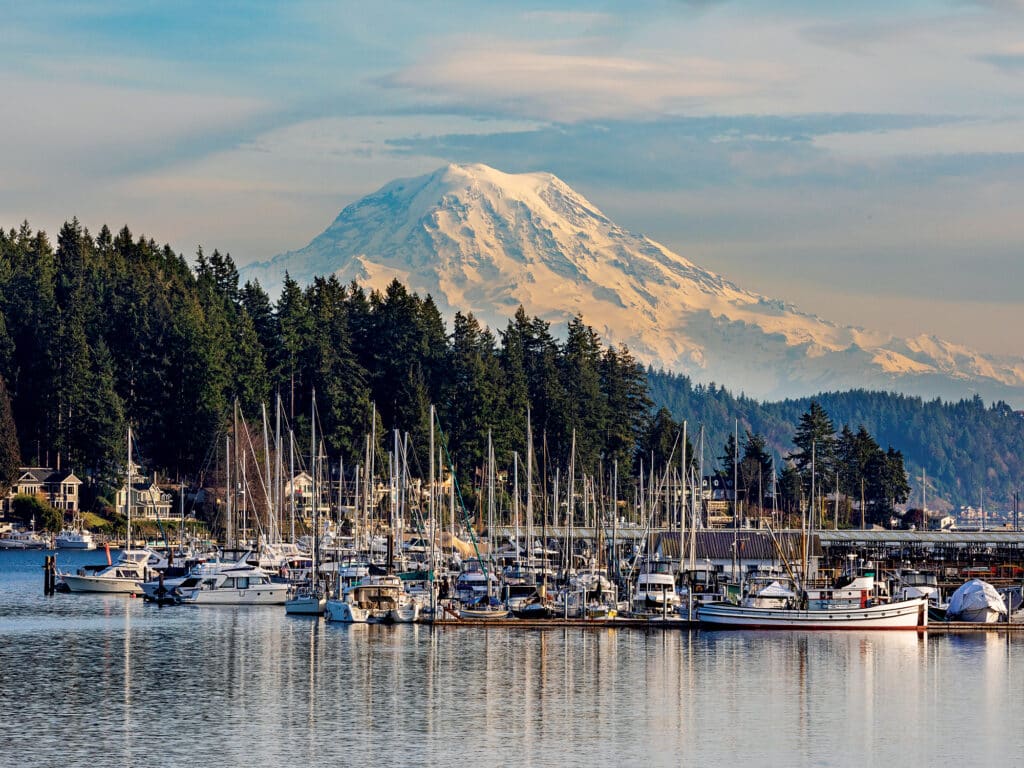
This was shaping up to be an ideal adventure, filled with solitude and unexpected experiences. It was also some of the best sailing I’d done on my Jeanneau 509, Kāholo. And it had all started with simple necessity: I had to move the boat to get new canvas.
In 2021, I had sailed new-to-me Kāholo 5,000 miles, across the Atlantic and the length of the Caribbean, from Portugal to Panama. While soaking under the torrential rains of Panama, I realized I definitely needed new canvas. Once we got to the Pacific Northwest, I learned that Iverson’s Canvas in Olympia, Washington, had a yearslong waiting list. And its team would not travel to your boat. Like the Soup Nazi in Seinfeld said, “No soup for you!” Unless you were prepared to travel.
Olympia is on the South Sound near Tacoma, 80 miles south of my winter berth in La Conner, near the San Juan Islands. Although I managed to secure a spot on Iverson’s busy schedule, the only date its team could do the work was in mid-February, the coldest month of the year.
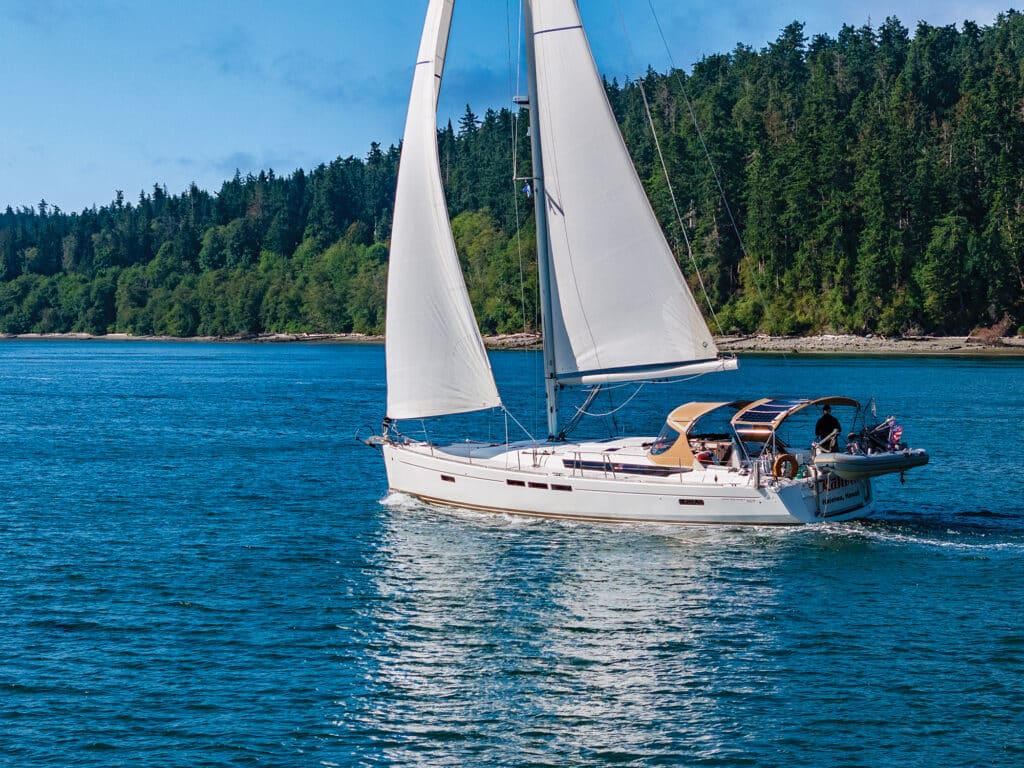
Well aware of the shifting weather systems in Puget Sound, I stacked things in my favor by leaving plenty of time to choose a weather window. As luck would have it, a high-pressure system was set to fill in, bringing a favorable, but very cold, northerly wind. To get ready for the next day’s northerlies, Tracy and I made a short sail out to the historic town of Coupeville on Whidbey Island, where we spent time in a warm pub with the colorful local crowd that had replaced the summer tourists. Well-fortified against the cold, we paddled back out to lonesome Kāholo, the only anchor light in the anchorage.
Leaving Coupeville early, we had a serene reach south in calm water, all alone, jibing back and forth across Possession Sound under an asymmetrical spinnaker. It was challenging sailing in shifting winds, amid evergreen-covered islands down Whidbey, the second-longest island in the United States, after New York’s Long Island.
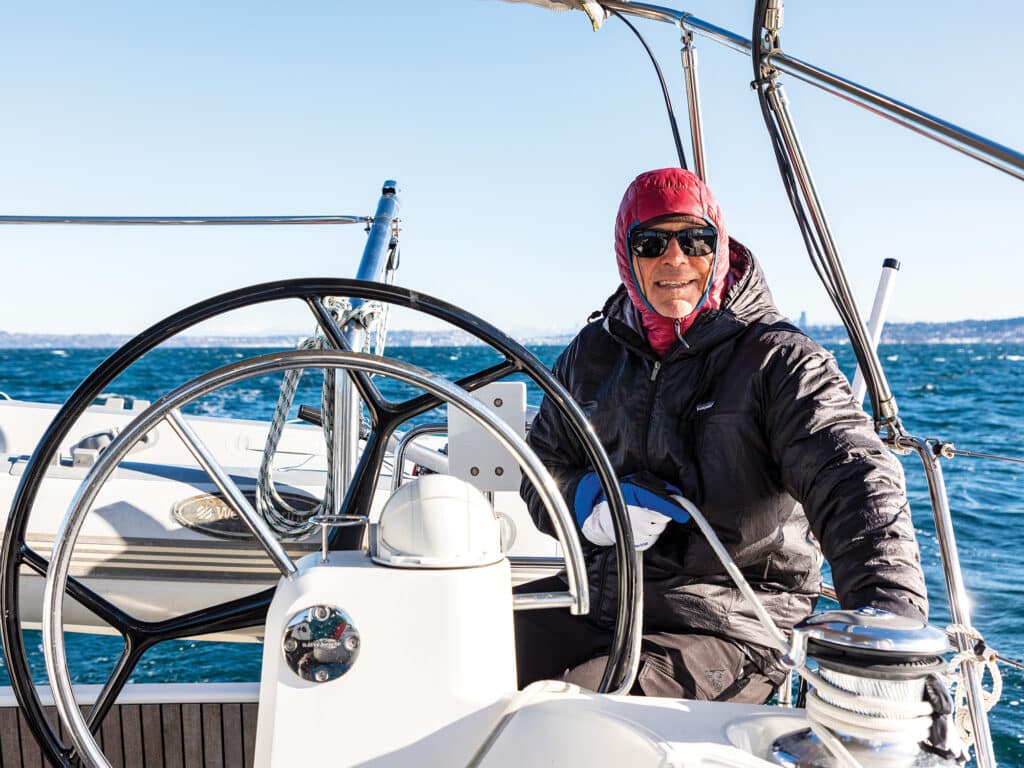
The wind began to build as we neared the bottom of Whidbey. The helm felt lively. Somewhere around freezing, the wind sent a chill right through me. Adding another puffy jacket at the helm, I was quite comfortable but looked like the Michelin Man.
We blew right past the mooring I’d had in mind for the end of the short winter day, not to mention the alternate destinations I’d marked off in case the weather or the gear failed to cooperate. This was no ordinary sail, and we were having too much fun. We continued south toward Seattle.
Passing the southern tip of Whidbey Island, we sailed into the comparatively open water of Admiralty Inlet. Both the seas and the wind began to build. Now we were reaching at 12 knots with more than 20 knots of apparent wind. This was the upper limit for the spinnaker. The boat was handling well, but I could feel the rudder loading up as the boat leapt through the following seas. Rounding up in this wind with the spinnaker would mean taking it down in pieces. Breaking seas to windward alerted me that the wind was still building in the exposed waters of Admiralty Inlet. As the saying goes, any fool can put up a sail, but it takes a sailor to know when to take one down—and I’d apparently left it a bit late.
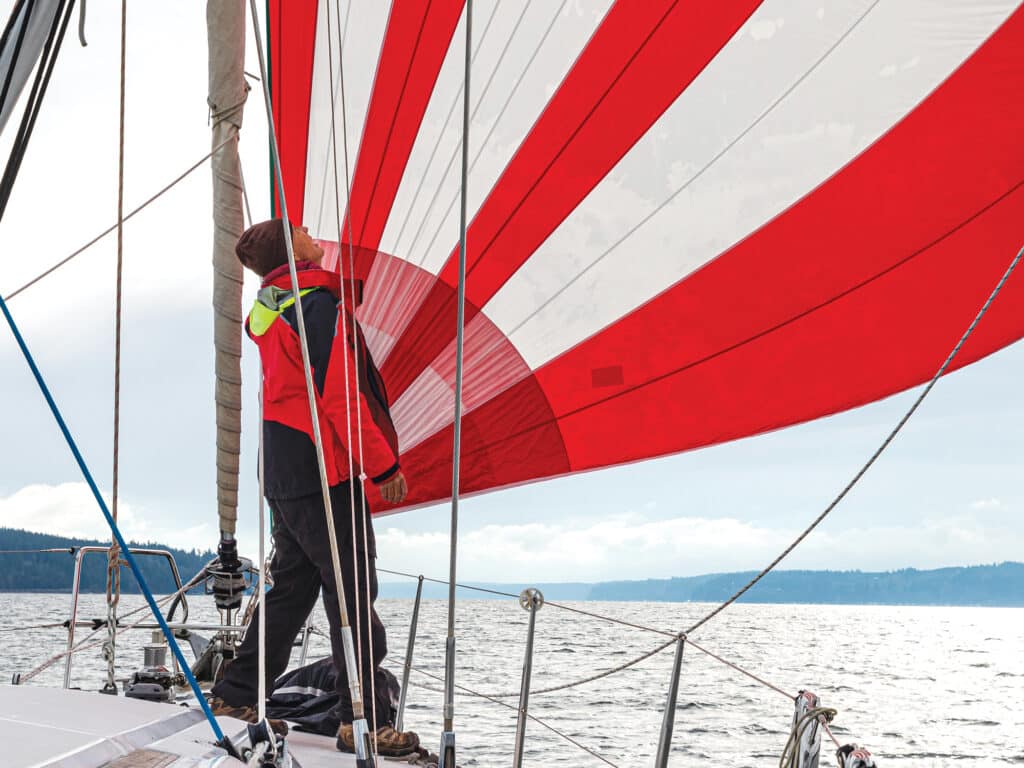
“Tracy!” I called out. “We need to get that spinnaker down. Now!”
As Tracy hustled forward, I brought the boat downwind to hide the spinnaker behind the main. Tracy tried to douse the sail, but the sock refused to come down. The spinnaker sock lines had become tangled after so many jibes. I managed to balance the boat on a deep reach, with the seas slewing her around and the spinnaker flailing behind the main. I set the autopilot, praying we wouldn’t wrap the sail around the forestay, and jumped forward to help. We managed to untangle the lines while the autopilot miraculously kept us safely off the wind. The sock finally slid over the unruly beast and we dropped the sail to the deck with a sigh of relief. After that battle, we were no longer cold. The wind increased to the point to where the working jib was now plenty of sail, and we surfed south to Port Blakely, just across Puget Sound from Seattle on Bainbridge Island.
We arrived as the sun set and the lights of Seattle came alive in a purple sky. We could see the huge marinas of Elliott and Shilshole bays, housing thousands of boats. Yet we were alone, swinging at anchor in a quiet cove at the end of a perfect weekend sailing day. Finally, one other sailboat joined us: a singlehander on his 30-foot Wauquiez.
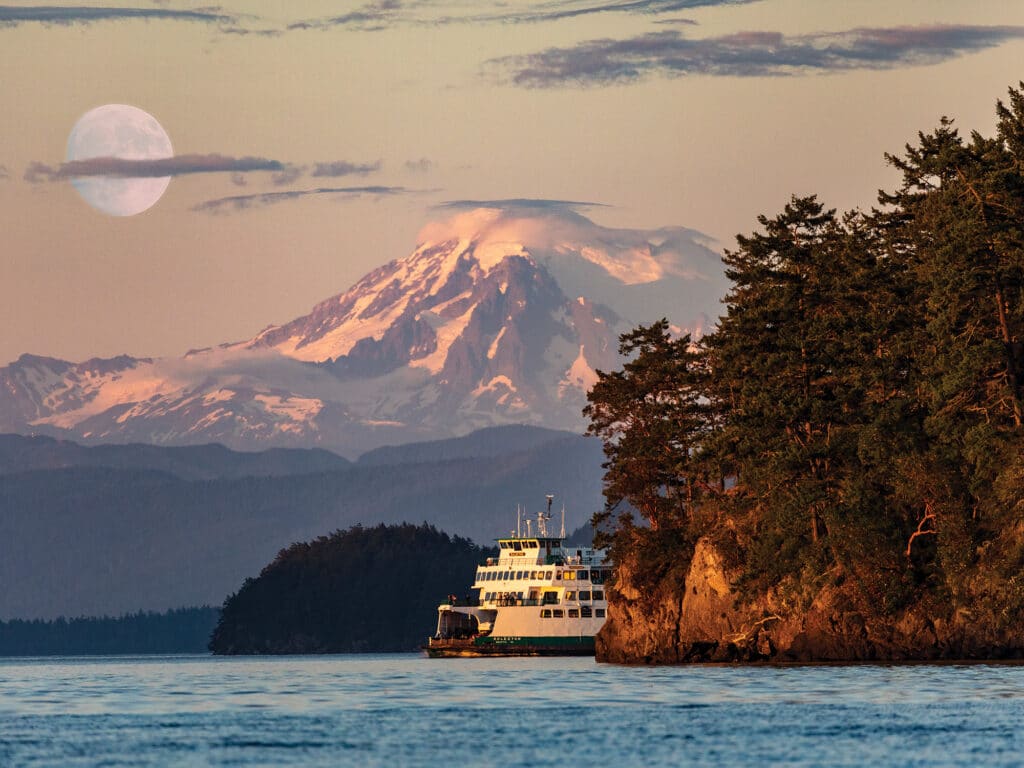
With the setting sun, temperatures dipped well below freezing. Luckily, we had thick down comforters on the bunks to keep us warm. In the morning, I found water pooling on the floorboards, something no captain wants to see. Assuming we had a freshwater leak in one of the pressurized lines, I pulled off panels to reveal the hullsides. They were running with water. In freezing temperatures, comparatively warm moist air inside the cabin condenses on the cold hull of the boat “like a cold can of soda on a hot day,” as one sailor described it. I immediately invested in a dehumidifier for use at the dock. The proper solution while underway would, of course, be a diesel heating system.
The northerlies were still blowing the next day, and we raised the spinnaker again, doing an outside jibe back and forth down serpentine Colvos Passage to Gig Harbor. For an outside jibe, I bring the boat directly downwind, jibe the main to put the boat wing on wing, and then completely release the working spinnaker sheet, letting the spinnaker flag in front of the boat. I then turn the boat through the wind, onto the new tack, and haul in the leeward spinnaker sheet, which is led around the bow on the outside. I can do this singlehanded, and it works like a charm as long as the sheets don’t get snagged on anything. Sadly, they often do, which requires a trip to the foredeck to unsnag them.
Gig Harbor was where we’d planned to meet the team from Iverson’s Canvas. A lively harbor town shadowed by Mount Rainier—with several marinas, a fishing fleet, a strong paddling scene, and lots of maritime history—Gig Harbor was named in the 1800s for Capt. Wilson’s gig, or rowboat, brought into the narrow entrance for shelter. The town is home to Gig Harbor Boat Works, which builds traditional gigs from modern materials.
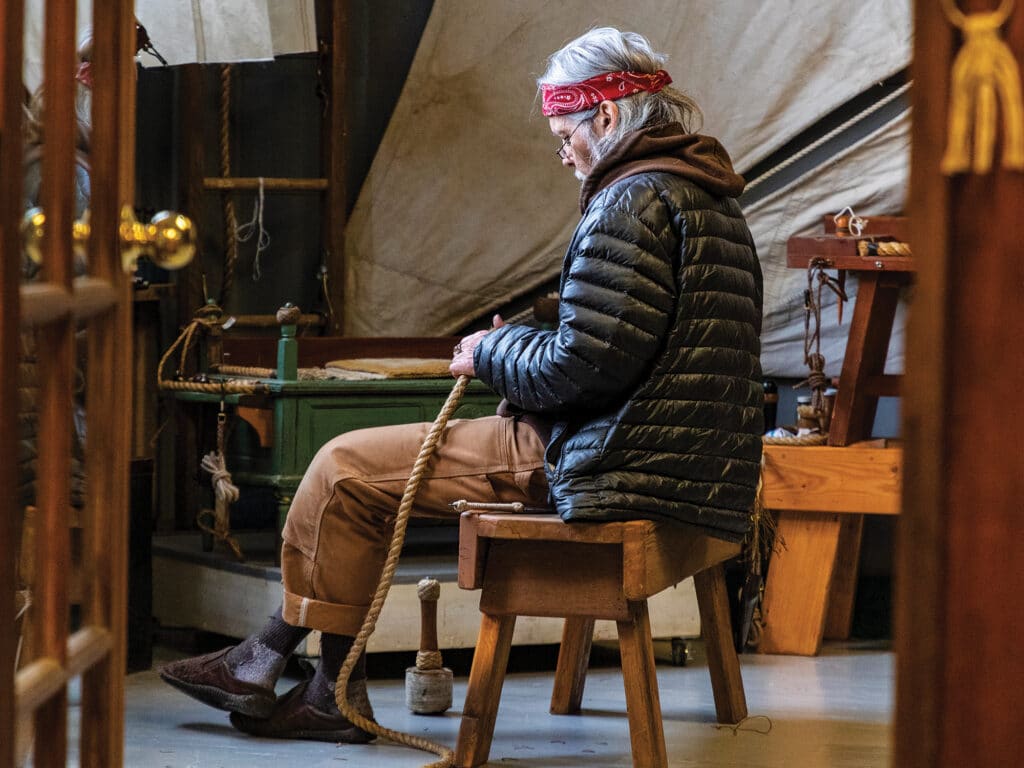
It was amazing to watch Kyle and Mike, two guys from Iverson’s. They installed custom, large-diameter stainless, and patterned the entire dodger and Bimini top with plastic sheeting, all in a day. They said it would be two weeks for me to receive the dodger and Bimini top, but they were back a day early. The new dodger transformed the cockpit, with better visibility and clear windows. It felt as though I’d been upgraded to an ocean-view home after cowering under an old tent for years. It wasn’t cheap, but it was money well spent.
As luck would have it, sailing north back up Puget Sound was also a downwind run. Southeasterlies are quite common in winter, often associated with the approach of a low-pressure system. This was exactly the case I encountered: An approaching low was sending me 15-knot southeasterlies. I jibed back and forth up the sound, this time singlehanding because Tracy had flown back to Hawaii. Often, I would tangle the sheets on some obstacle on deck or on the anchor, and I’d need to hustle forward to free it. On my last jibe across Admiralty Inlet, on a layline for Port Townsend, I noticed the unmistakable T-shaped mast of a submarine steaming at me en route to the naval yard at Bremerton. Two oceangoing tugs and two US Coast Guard vessels were in escort. Soon, the Coast Guard politely hailed me: “Sailing vessel Kāholo, I see that you are making tracks for Marrowstone Point. We request that you keep as close as you feel safe to the shore. We will be turning right, into your path.” Good thing I was on a layline, with good speed, and didn’t plan another jibe. The consequences of something going wrong were too great.
An old friend, veteran bluewater sailing instructor John Neal with Mahina Expeditions, met me at the dock at Port Townsend. He showed me around the bustling boatyards and introduced me to his favorite sailmaker, Port Townsend Sails, and riggers, Port Townsend Rigging. These are family operations where attention to detail and craftsmanship are the rule. John says that he can get 50,000 to 55,000 miles (two circumnavigations) on a single main and jib built by the craftspeople at Port Townsend Sails, who, by the way, are all women.
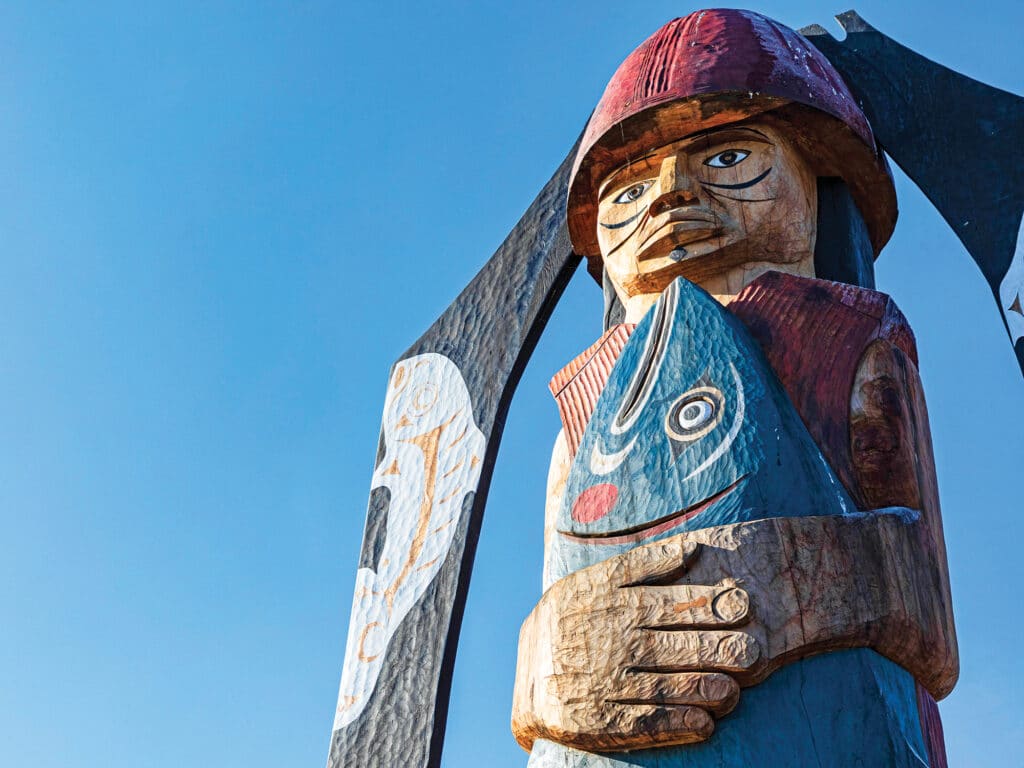
I set out on foot to see the boatyards at Port Townsend, the premier wooden-boat building and repair region on the West Coast. It’s a dynamic place where the next generation of shipwrights learns traditional skills at places such as the Northwest School of Wooden BoatBuilding. I wandered around the yards, amazed at vessels like the 133-foot San Francisco bar pilot cutter Adventuress, built in 1913 and still sailing here.
Port Townsend is famous for its annual wooden-boat show, but what seems to have escaped worldwide notice is that Kirsten Neuschäfer, the South African sailor who recently became the first woman to win the Golden Globe round-the-world race, sailed a Port Townsend boat: a 36-foot, 1988 fiberglass-hulled version of a traditional 1930s design built by Cape George Marine Works. Her boat was among only three boats to finish the grueling race without pause for repairs, and it survived 235 days at sea around the tempestuous Great Capes—and with Neuschäfer managing to rescue a skipper whose boat had sunk.
Continuing my stroll through Port Townsend on this cold, blustery afternoon, and seeing a small sign advertising “sails and canvas built and repaired” on an old wooden building in the harbor, I ducked into a shop called The Artful Sailor. Engulfed by the smell of tar, hemp and linseed oil, I found Emiliano Marino and Pami-Sue “Salty Sue” Alvarado practicing the ancient art of marlinspike seamanship. The late-afternoon light streaming in through the windows made it look like a scene from an old Dutch painting.
Only in Port Townsend could a sailor encounter a nuclear submarine, see a 1913 schooner and meet a couple practicing traditional marlinspike splicing, all in the same day.
Unfortunately, my luck ran out with the weather, and I sailed the 30 miles up to Deception Pass and to Kāholo’s La Conner slip in full foul-weather gear, in cold, drizzling rain and variable winds. The ending was a bit of a letdown, but overall, this had been an unforgettable voyage, precisely because it had happened in the dead of winter.
Not that I am planning any Shackleton-esque small-boat crossings in the Antarctic, but at least now I understand the beauty of a winter’s sail. Next on the my shopping list? A diesel heater.
Tor Johnson is an award-winning photographer and writer who has shot 16 covers of CW, so far. He grew up sailing the world with his family.








